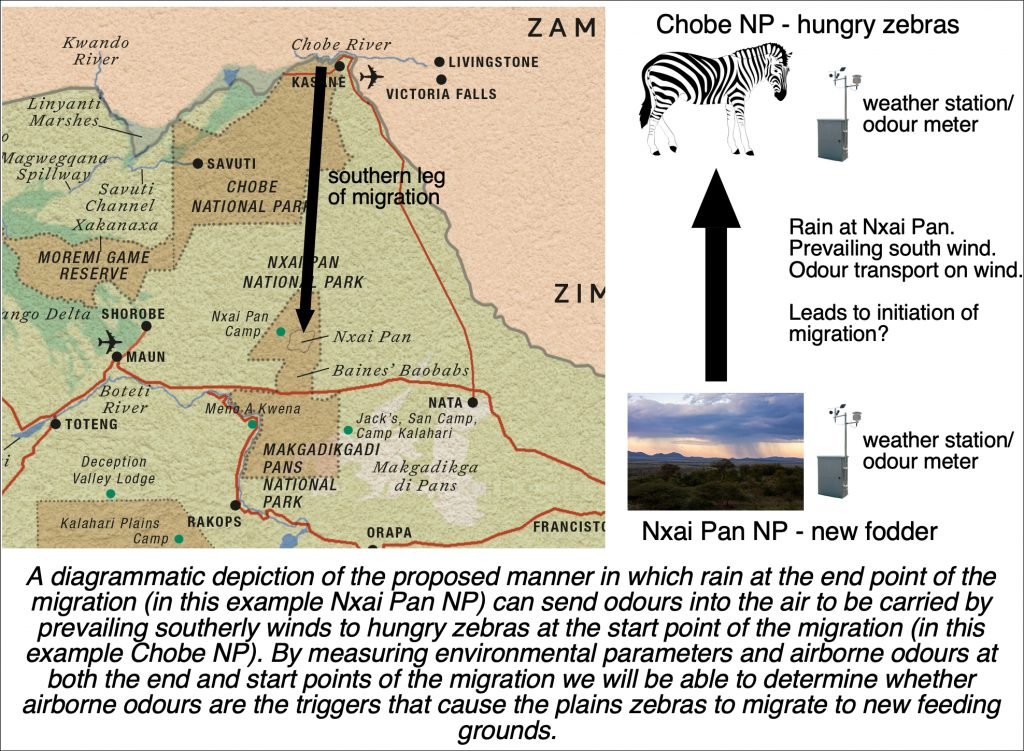Do olfactory cues initiate the migrations?
While it is known that the migrating animals (plains zebras and others) are moving between seasonal feeding grounds, it is unknown what signal/s indicate that it is the right time to migrate. Much of this project focusses upon the need to navigate the migration path, using what we believe is a uniquely evolved cognitive specialization; however, it is also important to understand what signal/s initiate migration. While it is known that the migrations are related to seasonal rainfall and associated floral abundance, underscoring the necessity of migration for their survival (Holdo et al., 2009), what triggers the animals to move from one location to another has not been explored in detail.
We propose that there are two specific conditions that need to be met for migration to be initiated: (1) An odour needs to emanate from the region to where the animals will migrate; and (2) A consistent prevailing wind from this same region needs to move the odour to the receptive animals.
While we can only propose potential odours, it would appear reasonable to think that the odour petrichor, the unique, earthy smell associated with rain, would be an appropriate target to investigate. The odour petrichor (Bear and Thomas, 1964) has, as its main components, the oils exuded by some plants (such as stearic acid and palmitic acid) that are absorbed into soils and rocks when there is no rain. After rain occurs, these oils, along with geosmin (a compound secreted by the bacteria Actinomycetes found in the soil), are mechanically released as aerosols. It would then be logical for these odour-containing aerosols to be moved by the wind, and if the prevailing wind blows in the direction of plains zebras that are ready to migrate (i.e., those ready to find better fodder), this odour may trigger the start of the migration.
Interesting anecdotal data supports the concept that both airborne odours and a consistent prevailing wind carrying these odours are required to initiate the migration. It has been observed that the plains zebras in the Chobe National Park often make “false starts” to their migration (where the move some distance along the migratory path and then return), sometimes up to 3 false starts can occur in a year. While rain may have fallen at their migratory destination (Nxai Pan National Park), and the appropriate odours may have become airborne, changes in the direction of the prevailing winds may lead to these false starts. Perhaps only after a sustained period (maybe 2-4 days?) of prevailing winds coming from the direction of the migratory destination, along with the appropriate airborne odours from the destination being carried on these winds, would the plains zebras decide it is the appropriate time to migrate.
Hypothesis: The combination of odour and appropriately prevailing winds are requisite to the initiation of migration.
Aim: To correlate the presence of airborne odours, prevailing winds, and the start of the migration, using the known southward leg of the migration in Botswana (Naidoo et al., 2016) as our model system.
Specific Objective 1: To measure levels of specific airborne odours leading up to the migration to provide the data required to see if odours such as petrichor can be considered specific triggers for migration initiation. These will be measured at both the location of the plains zebras prior to migration (Chobe National Park) and the location to where they migrate (Nxai Pan National Park).
Specific Objective 2: To measure relevant environmental parameters leading up the migration (air temperature, black globe temperature, relative humidity, wind speed and direction, rainfall, illuminance (lux) and solar radiation, although we will have a specific focus on the direction of origin of the prevailing wind leading up to the initiation of the migration). These will be measured at both the location of the plains zebras prior to migration (Chobe National Park) and the location to where they migrate (Nxai Pan National Park).
Specific Objective 3: As we will have several plains zebras outfitted with GPS collars in this region (see other sub-projects), we will correlate the movements of these zebras with both the odours detected and the prevailing wind direction, as well as other environmental parameters, to determine whether there is a strong correlation between these three factors.

Methods:
Specific Objective 1: To measure levels of specific airborne odours every 2 hours for a period of 6-8 weeks leading up to the migration. These will be taken with an automated system containing carbon thermal desorption tubes (e.g., Pengelly, 2020). The collected samples will then be analysed with compound appropriate methods, such as GC flame ionization (e.g., Chang et al., 2016).
Specific Objective 2: To measure 8 meterological conditions we will be using two semi-portable, solar-powered, weather stations (www.environdata.com.au/easidatamark4). We plan to record air temperature, black globe temperature, relative humidity, wind speed and direction, rainfall, illuminance (lux) and solar radiation, every 10 minutes for a 6-8 week period, leading up to, and just after, the initiation of the migration. These will be measured at both the location of the plains zebras prior to migration (Chobe National Park) and the location to where they migrate (Nxai Pan National Park).
Specific Objective 3: Appropriate statistical correlation tests will be run on the data obtained.
Sources
Bear IG, Thomas RG (1964) Nature of argillaceous odour. Nature 201:993-995.
Chang CP, Lin TC, Lin YW, Hua YC, Chu WM, Lin TY, Lin YW, Wu JD (2016). Comparison between thermal desorption tubes and stainless stell canisters used for measuring volatile organic compounds in petrochemical factories. Ann Occup Hyg 60:348-360.
Holdo RM, Holt RD, Fryxell JM (2009) Opposing rainfall and plant nutritional gradients best explain the wildebeest migration in the Serengeti. Am Nat 173:431-445.
Naidoo R, Chase MJ, Beytell P, du Preez P, Landen K, Stuart-Hill G, Taylor R (2016) A newly discovered wildlife migration in Namibia and Botswana is the longest in Africa. Oryx 50:138-146.
Pengelly I (2020) Thermal desorption part 1: introduction and instrumentation. Anal Methods 12:3425.
